New forms of global violence manufactured by capitalism
Debate

Guests: Maria Świetlik, Maciej Konieczny, Ala Qandil, Roman Kurkiewicz
Led by: Przemysław Wielgosz
When the hope of overcoming neoliberal capitalism moves away, the political horizon becomes darker. With the growth of the influence of the extreme, post-fascist right-wing in public life, violence began to spread. Violence – discursive, symbolic and physical – is a response to the fear associated with existence in a world of unpredictable changes, unexpected events and the future uncertain. The right-wing can play with this dread, so that it does not turn into social anger and rebellion against the prevailing system. Therefore, it strengthens it, awakens and redirects it to the most vulnerable and vulnerable social groups, such as refugees. Righteous anger related to socio-economic inequalities, expropriation, gentrification, precarious work, social and economic degradation of the working and middle class, is channelled to those who have been forced to leave their homes and travel, in order to sustain the basic living conditions for yourself and your families. That is why it is becoming more and more important to understand the archaeology of right-wing and right-wing populism. It is not enough to repeat the thesis about the recurring history and recalling the schemes of the fascist and nationalist right-wing movements of the first half of the twentieth century; today’s right-wing is only remixing old languages and strategies, in essence creating a conglomerate, sometimes internally contradictory, but practical project that responds to the current situation of global capitalism, defined by financialization, ultrafast, liquid capital, various forms neocolonial exploitation. Violence substitutes for discredited politics, formal hierarchy, diversity which has been realistically undermined by neoliberal capitalism, and finally, loyalty to the ethnocultural group displaces class identification and non-ethnic forms of citizenship.
The violence of imperial wars and armed conflicts of indeterminate status carried out by states, security agencies, religious and party militias, armies of private corporations and ordinary gangs are spreading over vast areas of the global South. They have manufactured about 60 million refugees who are part of the largest number of migrants (250 million) in history. Naked violence also applies to labour relations. There are today 40 million modern slaves in the world, most of whom are people who are not paid for compulsory work. Both phenomena are closely related – it is migrants and refugees who are most exposed to slavish exploitation. Both phenomena are part of the process of accumulation of primary capital, returning during periods of capitalist crisis and slowdown in economic growth. Plunder, expropriation, colonialism, slavery and migrations occur when the return on investment turns out to be insufficient and the growth curve goes down or becomes flat. This is not, however, an abstract, delocalized process. According to the Global Slavery Index report, in Poland alone in 2016, there were over 181,000 modern slaves. Why is this phenomenon invisible, absent from the public debate? Why are these improbable data so little known? Where are the slaves in Poland and what situation are we talking about?
| Data | Czas | Tytuł | Miejsce | Wstęp |
|---|---|---|---|---|
|
April 14 2018
, 17:00
Saturday
|
17:00 |
New forms of global violence manufactured by capitalism |
Museum of Modern Art in Warsaw | Free entry |